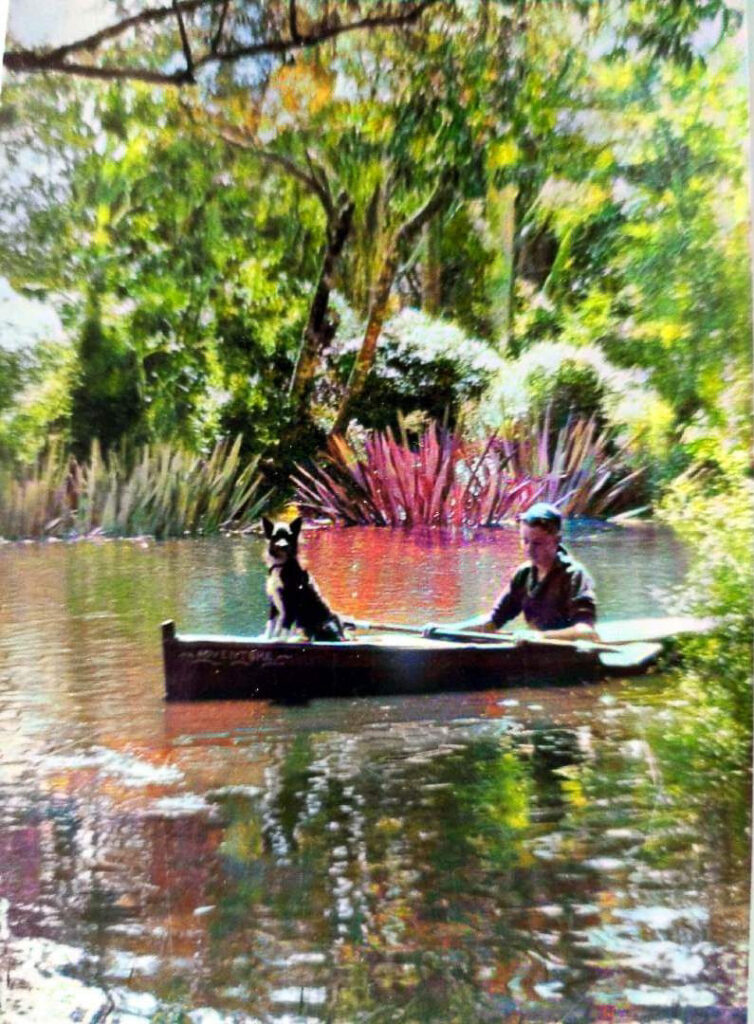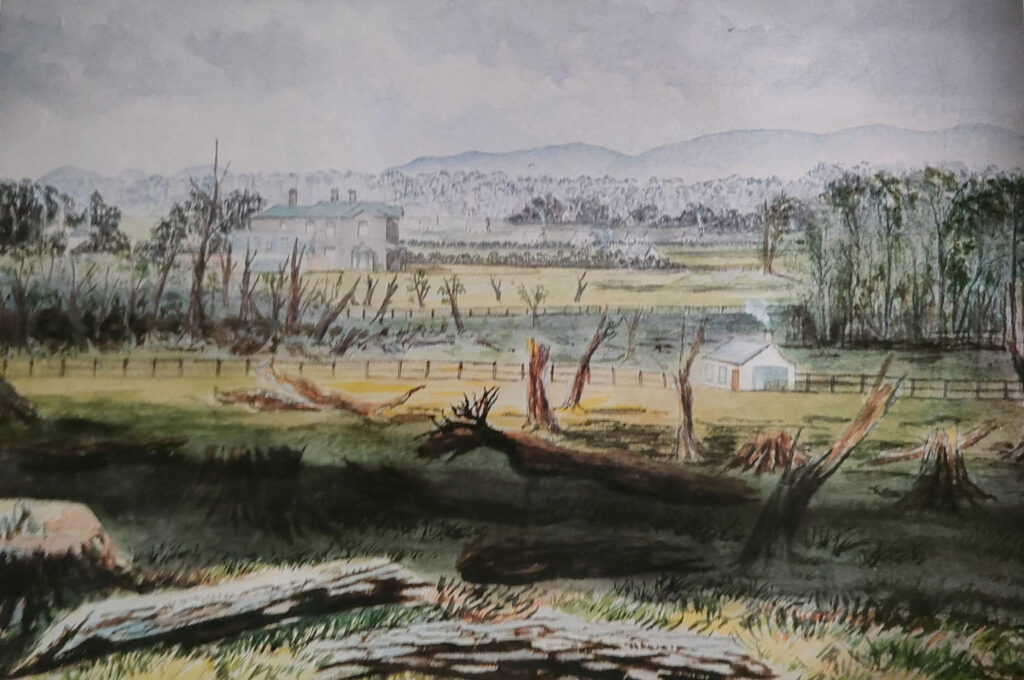Lennel History – Part 1

Photo: John and his wife and nine daughters, shortly after Lennel was built
Have you ever taken a slow stroll on a Sunday afternoon, stopping briefly to view an old tree and wondering what it might have seen over the years? Was it there before the motorcar? Maybe even before the horse and carriage?
If your stroll takes you around some of the tree-lined streets of Invercargill, the answer might be ‘yes’. It’s no accident either. The design for Invercargill was remarkable for a number of reasons. Firstly, the main streets were made twice the usual width. This was an amazing foresight, the benefits of which are felt today, with traffic able to navigate the centre without the usual slow crawl of other city centres. Secondly, Invercargill was designed to be surrounded by reserves. Trees had their place.
We can thank a gentleman by the name of John Turnbull Thomson for this. His legacy in New Zealand is breathtaking in its scope. Even if most may be unaware of his influence, it surrounds us. This is especially true for the Finlayson family.. They live at Lennel, which was once the pride and joy of Turnbull Thomson and home to his large family. Large might even be an understatement, as John and his wife, Jane, had nine daughters. That’s certainly enough to fill the rooms of Lennel with laughter and joy.
The house itself was named after a village located on the Scottish border, which has been known by slight variations of the same name since 1120, being at one time ‘Leinhale’, Leyonall’, ‘Leinhall’ and ‘Layenall’ The Anglo Saxon ‘len’ signifies a bend in the river, while ‘hal’ means large house. These days, it’s known simply as Lennel, which is the name Turnbull Thomson adopted for his home. Fittingly, it is both near a river and large, making it the very essence of the meaning of the name.

Photo: Ted Hall Jones (who died in WW2), on the Waihopai River
The nearby Waihopai River was used to transport the bricks used in the construction of the two-storey home. The Thomson family could each have a bedroom (8 in total), run around and entertain, with near countless dressing rooms, dining rooms, a study, nursery, kitchen, scullery and wash house. Not that they would have wanted to stay inside. That’s because all they needed to do was to open the front door to be transported to nature’s playground, with a well-thought out and cleverly pre-planted garden, surrounded by some 300 acres of wonderful Southland landscape.
To help picture it a little better, most of the suburb of Gladstone was part of the property, as was Thomsons Bush (yes, that is how it got the name). Essentially, it covered all of the land between what we now call Herbert Street, all the way along to Bainfield Road. There were Orchards, with trees providing apples ripe for scrumping, meadows for cattle, and more than enough places for the Thomson children and their grandchildren, many of which were raised at Lennel, or would visit regularly to play whatever game came to their fancy.

Painting by John Turnbull Thomson’s granddaughter looking from James Hargest Junior site
The sheer scale is hard to imagine now and the number of trees and plants would have been staggering. The Easy Big Trees nursery is one of the largest in the South Island and we have over 100,000 plants. Yet our nursery would only take up 10% of the Lennel land. It’s no wonder the Turnbull family had some help in the garden then.
That garden was referred to as a ‘Gentleman’s Garden’, which does conjure forth images of well-dressed men sitting on cane furniture, smoking pipes and talking politics as they casually consume port through a delicate sifter. Charged with looking after the garden was Albert Newman, who lived on site and would have a lasting horticultural impact that extends beyond the gardens borders, naming a rhododendron after his mentor, Charles Lawson.
The rhododendrons are still there today, where they are protected and even require an assessment and report before they may be pruned. There also remains a weeping ash, along with a Copper Beech that was specially transported by ship to New Zealand, and then planted at Lennels to celebrate the Diamond Jubilee of Queen Victoria in 1897.
Nearby were the stables, an orchard and the plant nursery. It would have been the most amazing place to work and, for gardener Albert Newman, we think it was. It certainly would have afforded him some time in fresh air to think about other things, as Albert was a busy man. Twice Mayor of Gladstone, he was arguably as well known in local politics as he was in horticultural circles. Albert died in 1931, having long retired, and was survived by 3 sons, one of whom distinguished himself at Gallipoli, winning a military medal.
John Turnbull Thompson himself was not so fortunate in the longevity stakes. He was to die just two years after Lennel was completed, in 1884. Of course, his legacy lives on and that’s the reason we are taking this detour down History’s path. Today, Lennel is going through a resurgence and we’re pleased to be assisting with the provision of advice and trees to the current owners.
The ‘Gentleman’s Garden’ is once more taking shape, while the rooms of Lennel are once more filled with laughter and joy from children. But while the grounds may be significantly smaller than they once were, the task of bringing them and the property back up to full glory is bigger than it has ever been.
In part 2 of Lennel: The Original Garden of Invercargill we’ll bring the story up to date, including tales of mushrooms growing on the floor of the home, a 1924 Dodge with a tree growing through it, and the curious discovery of concrete pipes that don’t appear on any record, with no-one knowing where they start or where they end.
Anzac Day – Lest We Forget
Autumn Colours – Part 2: Maples at Millbrook
Archives
- April 2024
- March 2024
- February 2024
- January 2024
- December 2023
- November 2023
- October 2023
- September 2023
- August 2023
- July 2023
- June 2023
- May 2023
- April 2023
- March 2023
- February 2023
- January 2023
- December 2022
- November 2022
- October 2022
- September 2022
- August 2022
- July 2022
- June 2022
- May 2022
- April 2022
- March 2022
- February 2022
- January 2022
- December 2021
- November 2021
- October 2021
- September 2021
- August 2021
- July 2021
- April 2021
- March 2021
- February 2021
- January 2021



